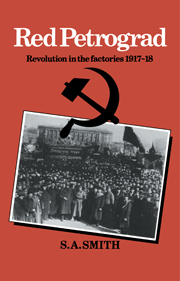Book contents
- Frontmatter
- Contents
- Acknowledgements
- Introduction
- 1 A profile of the Petrograd working class on the eve of 1917
- 2 The tsarist factory
- 3 The February Revolution: A new dispensation in the factories
- 4 The structure and functions of the factory committees
- 5 Trade unions and the betterment of wages
- 6 The theory and practice of workers' control of production
- 7 Deepening economic chaos and the intensification of workers' control
- 8 The social structure of the labour movement
- 9 The October Revolution and the organisation of industry
- 10 The economic crisis and the fate of workers' control: October 1917 to June 1918
- Conclusion
- Notes
- Bibliography
- Index
Conclusion
Published online by Cambridge University Press: 11 January 2010
- Frontmatter
- Contents
- Acknowledgements
- Introduction
- 1 A profile of the Petrograd working class on the eve of 1917
- 2 The tsarist factory
- 3 The February Revolution: A new dispensation in the factories
- 4 The structure and functions of the factory committees
- 5 Trade unions and the betterment of wages
- 6 The theory and practice of workers' control of production
- 7 Deepening economic chaos and the intensification of workers' control
- 8 The social structure of the labour movement
- 9 The October Revolution and the organisation of industry
- 10 The economic crisis and the fate of workers' control: October 1917 to June 1918
- Conclusion
- Notes
- Bibliography
- Index
Summary
The labour movements of Western Europe were dominated by skilled artisans for most of the nineteenth century. Trades, such as tailors, shoemakers, cabinet-makers, carpenters and the building trades, spearheaded the radical and labour movements. In contrast, the factory proletariat, which consisted to a large extent of women and children, was, with certain exceptions, badly organised and politically quiescent. Only in the last quarter of the nineteenth century did trade unionism begin to expand beyond the ranks of an elite of artisans and skilled factory craftsmen. The evolution of the Petrograd labour movement was far more telescoped that its counterparts in the countries of Western Europe. Although the number of strikes and informal labour organisations grew rapidly during the last quarter of the nineteenth century, it was not until the 1905 Revolution that a formal labour movement was inaugurated. Although artisans played an important part in creating trade unions and socialist organisations, by 1917 the labour movement of the Russian capital was based predominantly on workers in factory industry, workers employed in huge enterprises which were among the most modern in the world. Whilst this working class corresponded in some respects to the Marxian model of the modern working class, since it was employed in large-scale machine industry, in other respects, it was not yet a fully-developed proletariat. Within its ranks, urbanised, hereditary proletarians were still outnumbered by newcomers to industry, who retained strong ties to the countryside. The labour movement which was re-established in Petrograd after the February Revolution, therefore, had a hybrid character.
- Type
- Chapter
- Information
- Red PetrogradRevolution in the Factories, 1917–1918, pp. 253 - 265Publisher: Cambridge University PressPrint publication year: 1983



